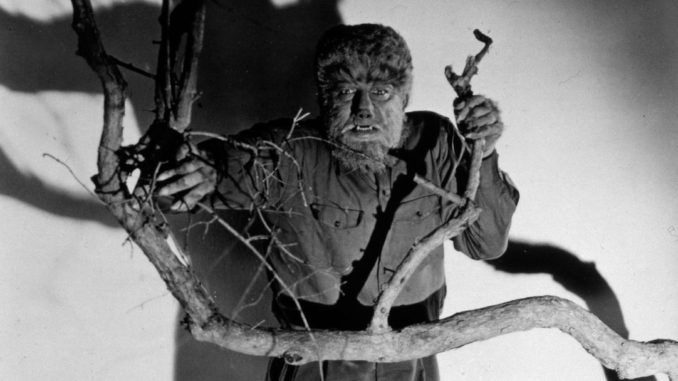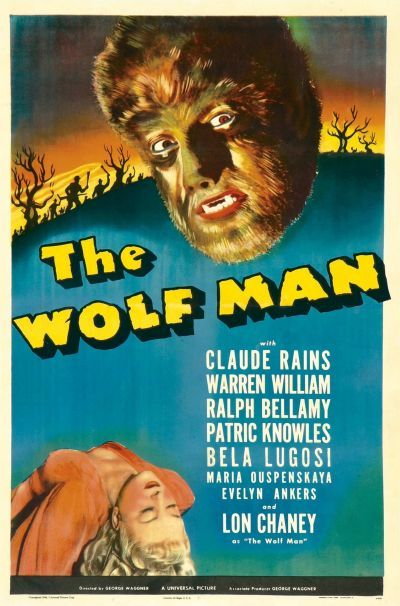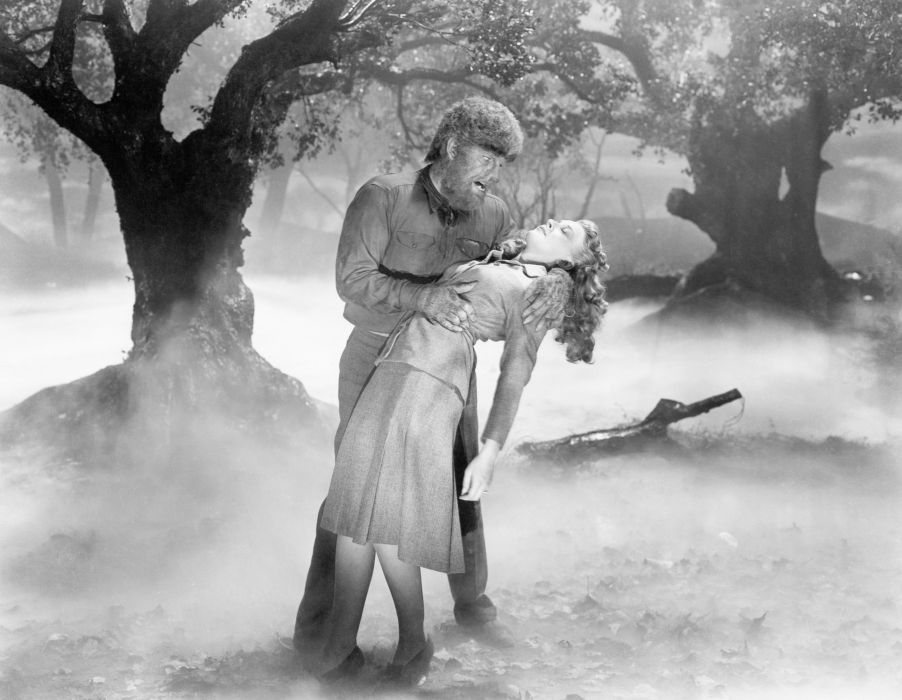
Rating: C
Dir: George Waggner
Star: Lon Chaney Jr., Claude Rains, Evelyn Ankers, Warren William
Seventy minutes. That’s all this lasts. But it’s not the shortest film, or the best of such length, we’ll be covering this month. The 7.2 IMDb rating here is surpassed both by 1931’s Frankenstein, 7.8 with the same running time, and the following year’s Freaks, which also rates a 7.8, yet comes in at a crisp sixty-four minutes. If you look at the top twenty films with the best IMDb rating (min. 5,000 votes) and a running time of seventy minutes or less, half were made before the outbreak of World War II, led by The Kid from 1921. The post-war ones are an odd grab-bag, including The War Game, The Match Factory Girl, and… um, Who Killed Captain Alex?.
Another data point. Of the eleven horror films in 1941 to have reached a thousand IMDb votes, only three run longer than The Wolf Man‘s seventy minutes. Just one, the adaptation of Dr. Jekyll and Mister Hyde starring Spencer Tracy and Ingrid Bergman, is over ninety. It comes in at a whopping 113 minutes, which must have seemed an eternity for audiences of the time. I found an interesting chart on Reddit, which shows how average running times have increased from ninety minutes to over two hours. But it looks as if the increase mostly happened through the mid-sixties, with the average then declining, before surging back up from the late-eighties on. To that end: Disney’s 1989 Little Mermaid was 83 minutes long; the live-action remake ran 135.
 I suspect a factor might be the switch from programs to individual features. Back in the day (gestures vaguely), your admission might get you two features, a newsreel and a cartoon. If that’s the situation, exhibitors are going to balk at long B-movies, as that’ll cut into profits. Though even then, epics from the likes of Griffith and De Mille touted their length as a selling point. Also, with everything screened digitally these days, there’s no additional distribution cost for a long movie over a short one, in terms of prints or shipping them out. But I suspect the average running time varies by genre. Across all 68 horror films with 5,000+ IMDb ratings last year, the median running time was less than an hour and three quarters. And that includes a number from Bollywood.
I suspect a factor might be the switch from programs to individual features. Back in the day (gestures vaguely), your admission might get you two features, a newsreel and a cartoon. If that’s the situation, exhibitors are going to balk at long B-movies, as that’ll cut into profits. Though even then, epics from the likes of Griffith and De Mille touted their length as a selling point. Also, with everything screened digitally these days, there’s no additional distribution cost for a long movie over a short one, in terms of prints or shipping them out. But I suspect the average running time varies by genre. Across all 68 horror films with 5,000+ IMDb ratings last year, the median running time was less than an hour and three quarters. And that includes a number from Bollywood.
But nothing came in below eighty-four minutes – almost a quarter-hour longer than the most famous horror film of 1941. It’s worth noting this wasn’t the first Universal werewolf movie. Six years earlier the studio had made feature-length lycanthrope film, Werewolf of London. It’s largely forgotten now – except for having inspired Warren Zevon’s song, courtesy of a suggestion from Phil Everly after he’d watched the movie. What’s interesting is, how elements we now take for granted are only tangential, if mentioned at all in these early entries. For example, that transformations occur during a full moon – now seemingly a core element of werewolf cinema – is not the case here.
Oh, the moon is brought up, in a poem which gets recited by everyone in the village: “Even a man who is pure in heart, and says his prayers by night, may become a wolf when the wolfbane blooms, and the autumn moon is bright.” Does “bright” = “full”? Unclear, and the poem was changed to mention a full moon explicitly in the sequels. Even the silver thing is a bit vague. While there’s a cane with a silver wolf’s head, used to bludgeon more than one werewolf to death, it feels as if the bludgeoning matters more than the silver. A bigger problem for me was hero Larry Talbot (Chaney). Most obviously, he returns to his ancestral Welsh home after 18 years away, sporting an obvious and irritating American accent. I have lived in the United States for 25 years, and do not have an American accent.
Then there’s behaviour best described as predatory, even before he grows hair and fangs. First thing he does is install a telescope in the attic, which he immediately uses to spy on the locals, peering into the bedroom of Gwen Conliffe (Ankers). He then goes to the antiques store where she works, uses what he’s seen, and keeps asking her out, despite repeatedly and explicitly being told, “No.” Maybe all this was acceptable in the forties? Admittedly, her inexplicable failure to mention at this point that she is engaged doesn’t help. But Larry already seems quite wolfy in nature, even before he’s bitten by a gypsy fortune-teller in animal mode (a cameo from Bela Lugosi). Angst follows, as Larry gradually realizes he can’t control his carnivorous urges, and the authorities close in on him.
 I will say, Chaney does become a more sympathetic figure as the nature of his condition worsens. He tries to confess, although understandably, his father (Rains) thinks it’s evidence of insanity. Naturally, it all ends tragically. In bludgeoning, as noted, with THE END then popping up on your screen, with almost unseemly haste. I suspect the other problem is that, of the Universal monsters, this is one reliant most on special effects. I mean, all Dracula needs is a set of fangs, a cape and an urbane European accent. Werewolves need a transformation as their money shot, and the kindest thing you can say is that Jack Pierce did his best. This has aged almost as badly as Larry’s dating technique.
I will say, Chaney does become a more sympathetic figure as the nature of his condition worsens. He tries to confess, although understandably, his father (Rains) thinks it’s evidence of insanity. Naturally, it all ends tragically. In bludgeoning, as noted, with THE END then popping up on your screen, with almost unseemly haste. I suspect the other problem is that, of the Universal monsters, this is one reliant most on special effects. I mean, all Dracula needs is a set of fangs, a cape and an urbane European accent. Werewolves need a transformation as their money shot, and the kindest thing you can say is that Jack Pierce did his best. This has aged almost as badly as Larry’s dating technique.
This stands in contrast to Cat People, made just a year later, but one which has stood the test of time better, in almost every way. I think it’s probably because it relies less on technical elements. Feels like Lewton and Tourneur knew they couldn’t deliver a convincing transformation, so didn’t try. Its absence looks better to modern eyes, than the slow dissolves used here. There’s a reason why my favorite werewolf movies, with the exception of The Curse of the Werewolf, date from the eighties or later. Among the classic Universal monsters, I think the werewolf may rank ahead of the mummy, but I suspect that’s it.
This article is part of our October 2025 feature, 31 Days of Vintage Horror.
